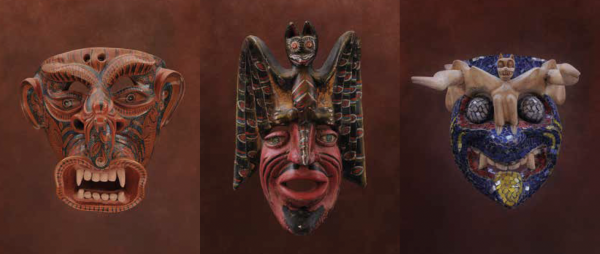Demand for Masks from Tourists and Collectors
The prevalence of masks in dances performed throughout the villages and towns in Mexico captured the interest of collectors in these fantastical creations, and in recent decades created a market for them as art objects. Older masks that were used in the dances at ceremonies and festivals are particularly valued. As demand from tourists and collectors increased, mask-makers began creating masks in greater quantity to satisfy the market. Their craft continued to evolve to the extent that by the end of the 20th century makers were producing masks with new and varied designs, the best examples of which can be considered masterpieces of Mexican folk art.
The Huichol (or their preferred name Wixárika) are an indigenous group from western Mexico. Best known for their use of peyote, the Huichol have a rich cosmology that revolves around four principal deities: Corn, Blue Deer, Peyote, and the Eagle. A relatively recent innovation in their art is the use of glass beads pressed into beeswax on a wooden form. These two masks show an older version of a mask along with one using this more recent innovation.
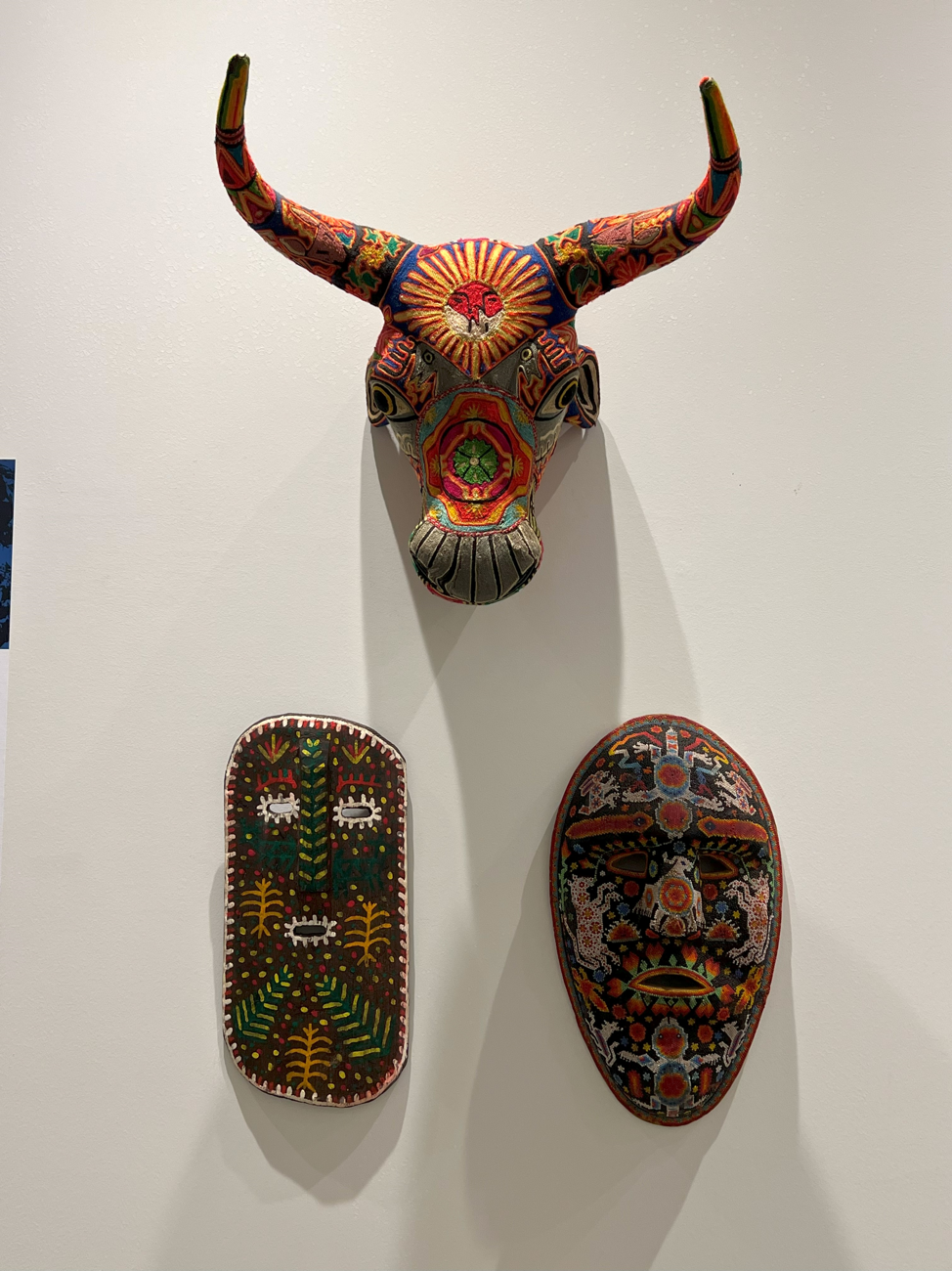 |
Top: Vintage Huichol Bull Left: Vintage Huichol Mask Bottom Right: Huichol Mask |
Bearded (Barbones) Masks
Often presented as being used in festivals, it is now generally accepted that the elaborate masks with dark, lush, curly beards (barbones) and hair were created for the tourist and art trade. Masks of this type are often oversized, skillfully carved, and striking in appearance. They may have their origins in the work of santeros, the carvers who created the saints and other images for Mexican churches. These carvers would have been very familiar with the carving styles of Europe, and the giant beards on these masks are like those of European baroque statues of figures like Moses and Neptune. As these masks increased in commercial popularity, they played a role in converting mask-making from an anonymous occupation to more of an art form associated with named artists and artisan families.
 |
Mask-making Families and Workshops
Some scholars consider that masks divorced from the dances, ceremonies, and festivals of communities are “fakes” that are empty and meaningless. The truth, however, is far more complex. Many of Mexico’s finest makers continue to create masks for public events but also create masks for sale to outsiders. These artists take immense pride in their work and regularly participate in shows and competitions that showcase masks. Rather than being anonymous carvers, these artists are gaining recognition with their own names and identities. The economic stimulus from tourists, art, and collector markets has created new opportunities for the continuation of longstanding traditions.
Salgado Masks from Uruapan, Michoacán
The Salgado family from the town of Uruapan in the state of Michoacán has become well-known for their artistry. The masks of Victoriano Salgado Morales are featured in the Great Masters of Mexican Folk Art. His and his family’s masks are used in festivals throughout the region. The masks are made from colorín (Erythrina americana) wood and fashioned using gouges, chisels, and knives. Paint, oil, and lacquer are applied, then decorative elements like eyes, beards, and lips are painted to give the masks their expressions. Devils, Moors, and viejos (old people) are frequent representations in the masks produced by the family.
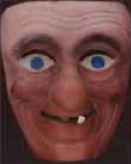 |
Viejo (Old Person) Mask Artist: Victoriano Salgado Uruapan, Michoacán Wood, Lacquer Mid-20th Century Loan from Robert Gaston |
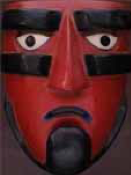 |
Moros Chinos (Chinese Moors) Mask Artist: Victoriano Salgado Uruapan, Michoacán Wood, Lacquer Late 20th Century Loan from Robert Gaston |
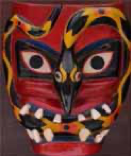 |
Devil Mask Artist: Victoriano Salgado Uruapan, Michoacán Wood, Lacquer Mid-20th Century Loan from Robert Gaston |
Jacobo Ángeles and María Mendoza of San Martín Tilcajete, Oaxaca
San Martín Tilcajete is a small, historical Zapotec town in the state of Oaxaca in southern Mexico that has become famous for its production of alebrijes, the wood carvings of fantastical creatures painted in bright colors. These have become popular with tourists and increasingly with art collectors. Although best known for their alebrijes, Jacobo Ángeles and María Mendoza also produce masks that have received recognition throughout the world. Jacobo has been named one of the Great Masters of Popular Art by BANAMEX and his work is regularly exhibited in such places as the Smithsonian’s National Museum of the American Indian. He and María use only naturally derived plants and materials for their figures and paints, and they are actively involved in reforestation efforts to preserve the copal (Bursera spp.) wood they use for carvings. Their workshop is a place in which other artisans from the town are employed and learn their craft.
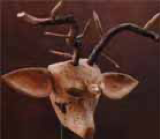 |
Venado (Deer) Mask Workshop of Jacobo and María Angeles San Martín Tilcajete, Oaxaca Wood 21st Century Loan from Robert Gaston |
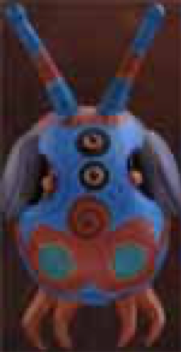 |
El Saltarín (Jumper) Mask Artist: Workshop of Jacobo and María Angeles San Martín Tilcajete, Mexico Wood, paint 21st Century Loan from Robert Gaston |
The Horta Family from Tócuaro, Michoacán
The small village of Tócuaro in the Mexican state of Michoacán has become famous for its religious festival in early February that celebrates the Pastorela or Shepherd’s Tale. This village is near Lake Pátzcuaro, a region known for communities that each specialize in a specific craft, such as copper pots and sculptures, pottery, lacquered plates, and woodworking. The wooden masks displayed here represent the characters in this play/dance that is performed in the main square of the community. The story that is portrayed is about how the devil tempts a shepherd who is on his way to visit the baby Jesus. Among the many individuals portrayed in the performance are shepherds, many incarnations of the devil, and the Archangel Michael. In addition, other masked dancers portray celebrities, cartoon characters, political personalities, and others who are tricksters attempting to distract and corrupt the shepherds. The satirical portrayal of politicians, elites, and celebrities is common in festivals throughout Mexico.
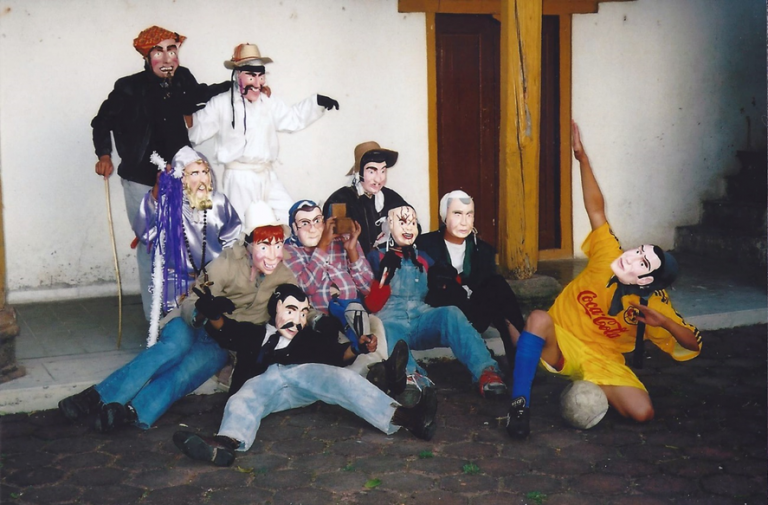 |
Tricksters and Shepherd from the Pastorela Tocuaro, Michoacán Photo by Bill DeWalt 2005 |
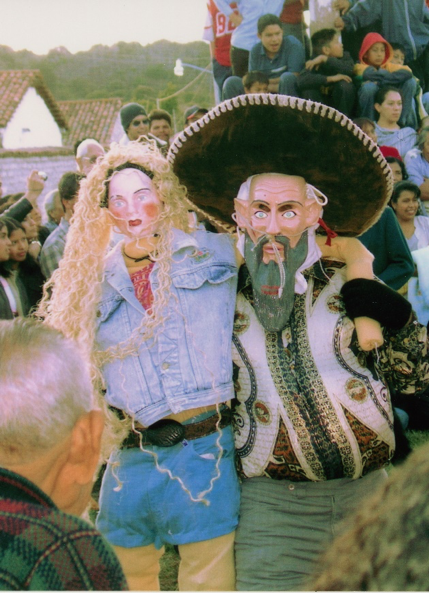 |
Mexican Macho and Gringa from the Pastorela Tocuaro, Michoacán Photo by Bill DeWalt 2005 |
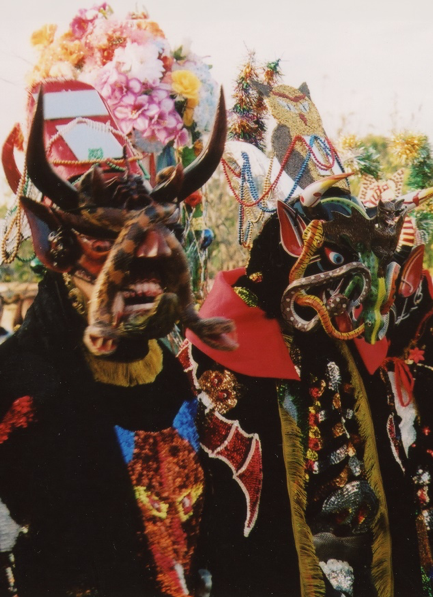 |
Devils at the Pastorela Tocuaro, Michoacán Photo by Bill DeWalt 2005 |
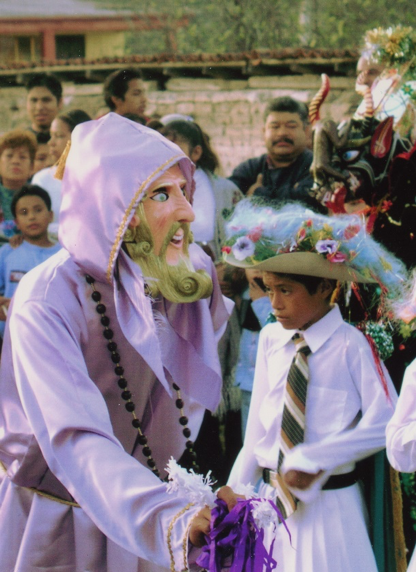 |
Shepherd Searching for Christ at the Pastorela Tocuaro, Michoacán Photo by Bill DeWalt 2005 |
The Horta family is the major mask maker for the festivals in Tócuaro. Justifiably, they have become famous locally, nationally, and internationally for their splendid masks, particularly of the many faces of the devil. Devil masks are also common in many of the other surrounding villages of Michaocán.
Video Resource: Máscaras - Tócuaro (Masks) featuring artesano Felipe Horta - YouTube
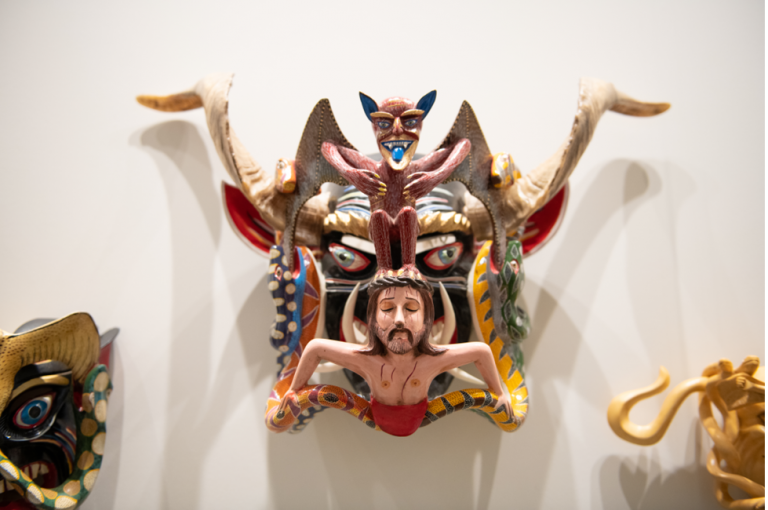 Devil Mask with Christ Devil Mask with ChristArtist: Felipe Horta Tócuaro, Michoacán Wood, horn 21st Century Loan from Robert Gaston |
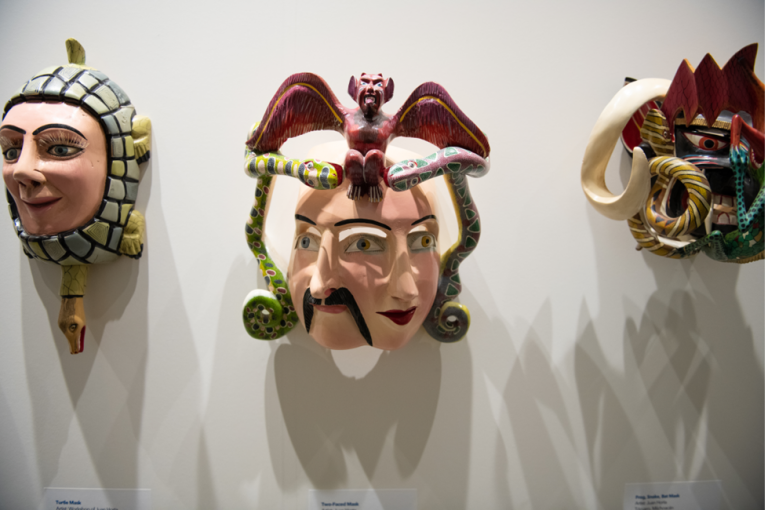 Two-Faced Mask Two-Faced MaskArtist: Juan Horta Tócuaro, Michoacán Wood, paint 21st Century Loan from Robert Gaston |
Vintage Dance Masks
It is impossible to estimate the number of masks that have been created and utilized over the years in the festivals and celebrations in Mexican towns and villages. Older, vintage masks are present in the collections of many museums around the world, and they are prized by collectors who value “authentic” dance masks. The masks in this section are examples of these vintage masks with several being more than a century old. Of note here is the wooden helmet and body armor that date to 17th century Mexico. This was worn in dances to represent Roman centurions during reenactments of the passion and crucifixion of Christ. At the time, the only reference the makers had for a soldier’s armor was what had been worn by the Spanish Conquistadors. This mask and body armor are stylized versions of what had been worn by the Spanish soldiers.
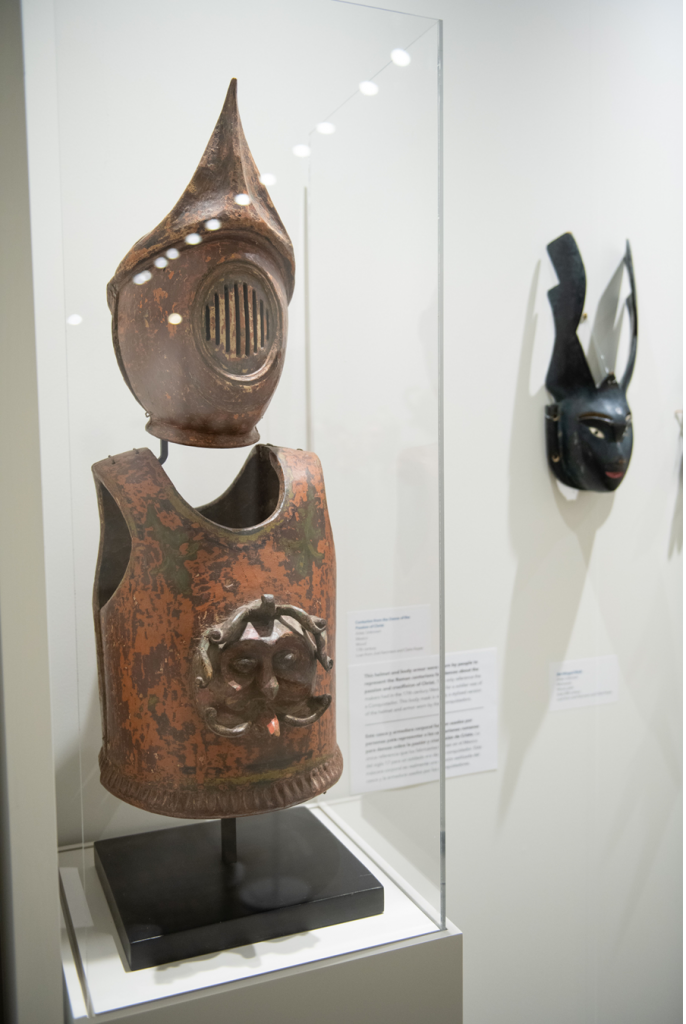 |
Centurion Helmet and Body Mask from the Dance of the Passion of Christ Artist: Unknown Mexico Wood 17th century Loan from Joel Aaronson and Claire Keyes |
 |
Bat Winged Mask Artist: Unknown Michoacán Wood, paint Early 20th century Loan from Joel Aaronson and Claire Keyes |
 |
Dance Mask Artist: Unknown La Parota, Guerrero Hammered Copper, Paint Early 20th century Loan from Joel Aaronson and Claire Keyes |
 |
Frog Dance Mask Artist: Unknown La Parota, Guerrero Hammered Copper, Paint Early 20th century Loan from Joel Aaronson and Claire Keyes |
 |
Bat Mask Artist: Unknown Oaxaca Wood, paint, chili peppers Early 20th century Loan from Joel Aaronson and Claire Keyes |


